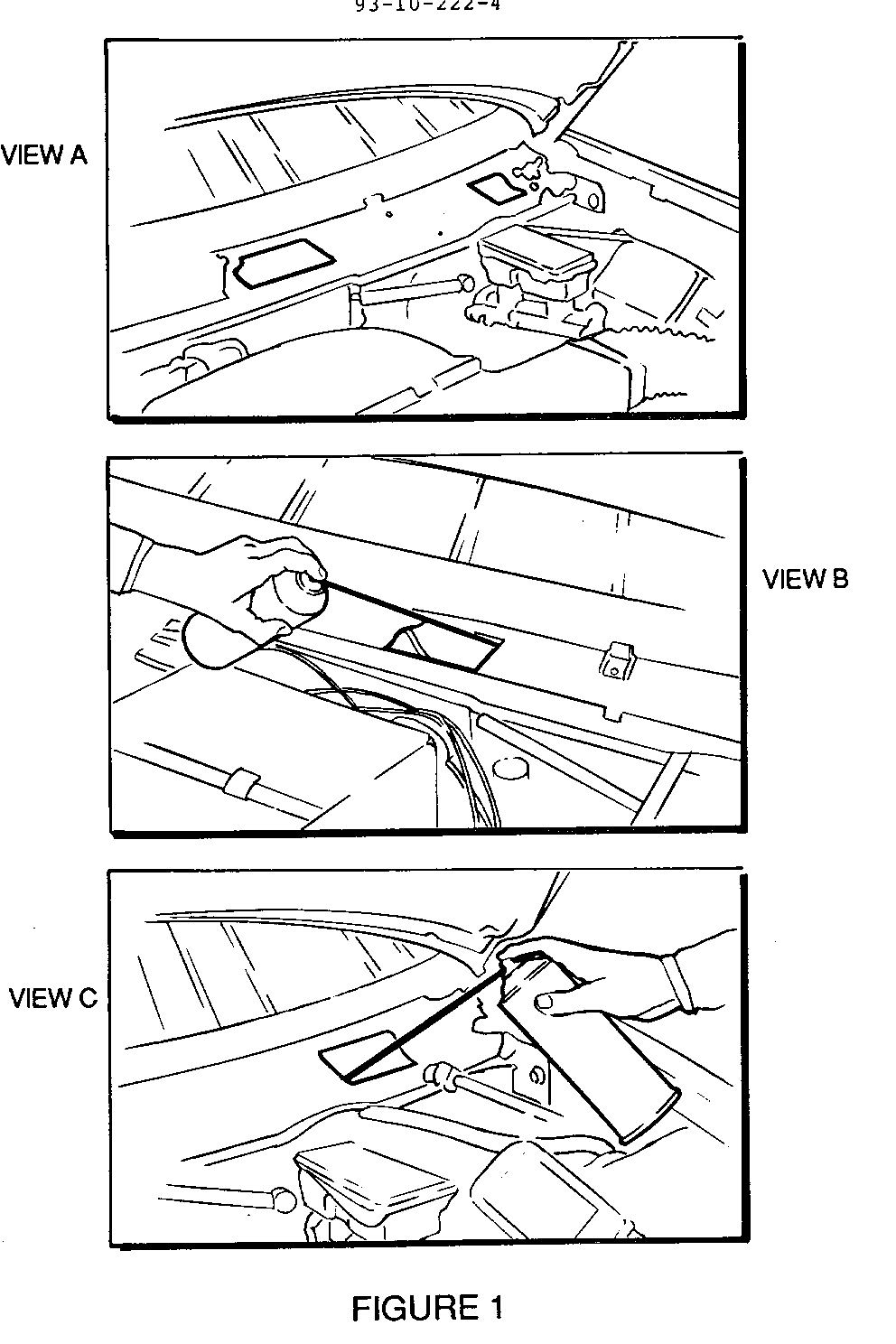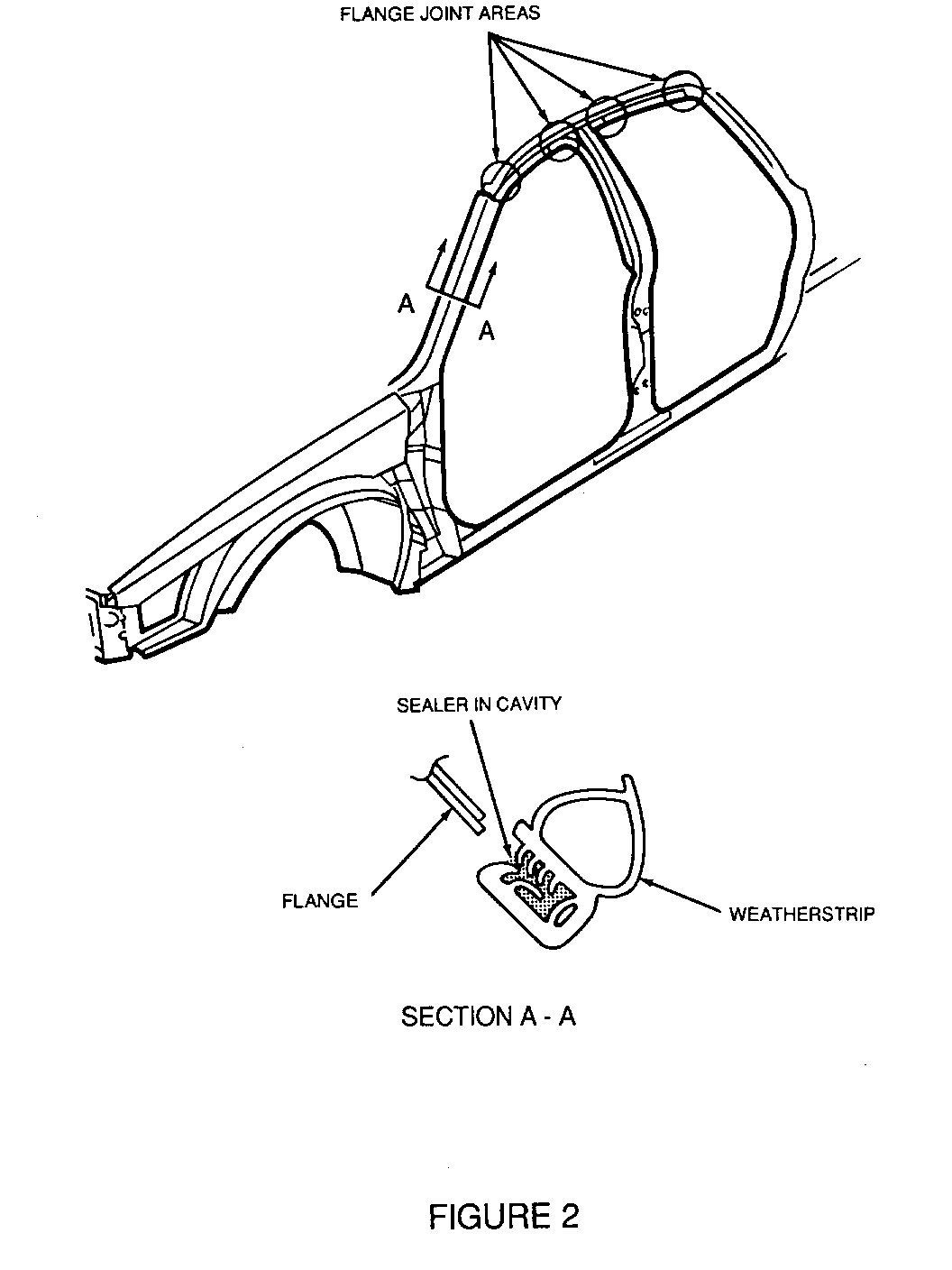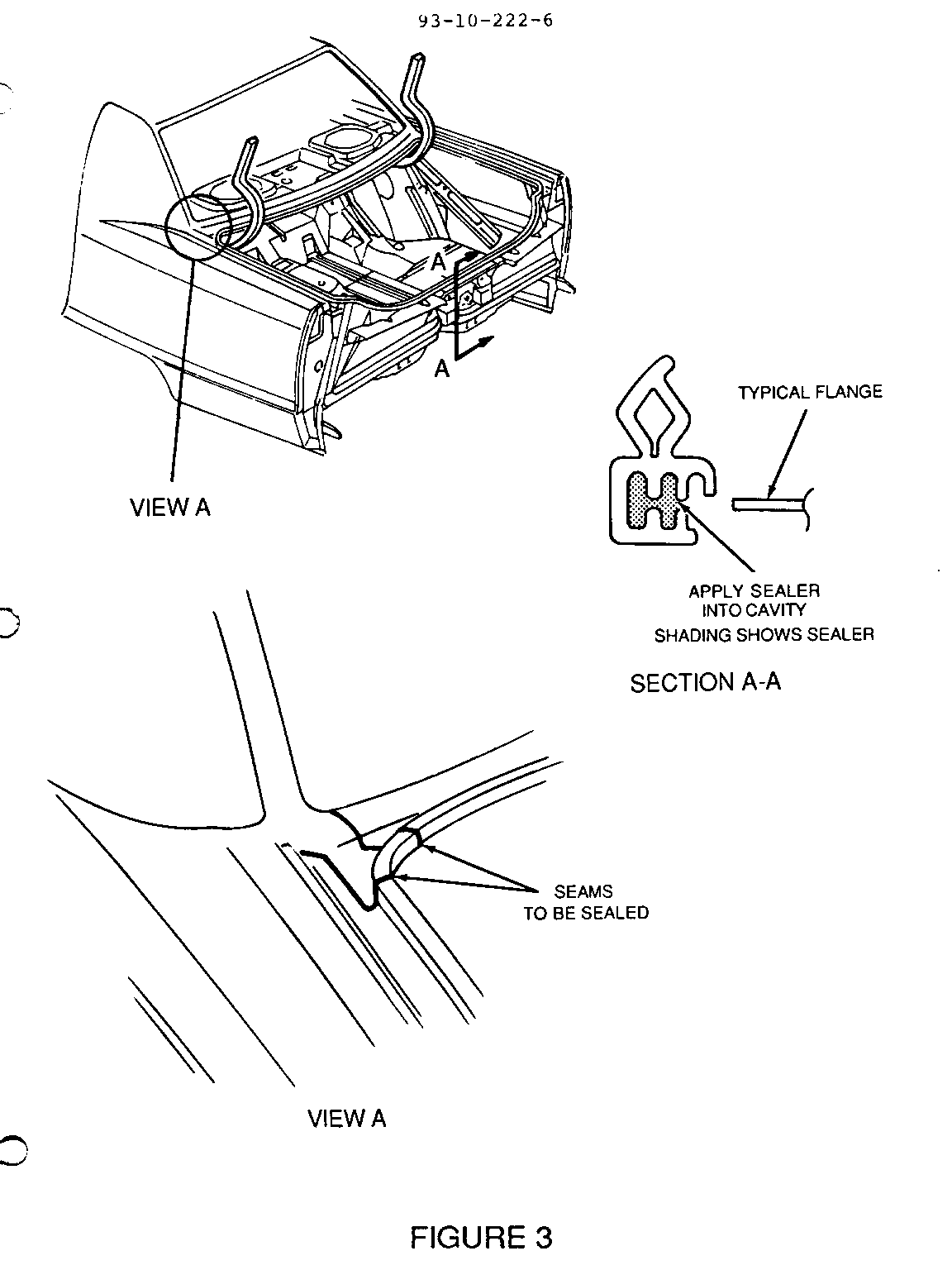WATERLEAKS-COWL AREA & DOOR WEATHERSTRIPS-REAR COMPARTMENT

SUBJECT: WATER LEAKS - COWL AREA, DOOR WEATHERSTRIPS, AND REAR COMPARTMENT (APPLY SEALER)
MODELS: 1993 FLEETWOODS AND FLEETWOOD BROUGHAMS (RWD)
Condition:
--------- Some 1993 Fleetwoods and Fleetwood Broughams (RWD) may have water leaks in cowl area, at door weatherstrips, and in the rear compartment area.
Cause:
----- Water leaks in the cowl areas may be due to:
0 Unsealed left side cowl seam inside of the cowl plenum creating water paths over grommets and brake booster holes. Refer to Figure 1.
0 Gaps or voids in the seam sealing between the cowl and the front body hinge pillar seams.
Water leaks at the front or rear door primary weatherstrip may be due to:
0 Lack of sealer in the mounting portion of the weatherstrip, especially at the flange joint areas. Refer to Figure 2.
Water leaks in the rear compartment may be due to:
0 Unsealed body seams below the back window and forward of the compartment opening.
0 Lack of sealer in the mounting portion of the weatherstrip, especially at the flange joint areas. Refer to Figure 3.
I. LEAKS IN THE COWL AREA ------------------------- Materials Required For Cowl Water Leaks --------------------------------------- 0 For cowl plenum seam leaks use:
- Kent SL-C, P/N 50265.
- 3M P/N 08994 Applicator, P/N 08633, Flow Grade Resealant (and a short length of hose.
- Kent P/N 90010 Applicator, P/N 10240, Rubber Sealer (and stock P/N KA-E Extension Tube).
0 For cowl/hinge pillar leaks use:
- GM P/N 12345743.
- 3M P/N 08648, or equivalent, Body Seam Sealers.
Cowl Area Leak For Cowl Plenum Seal (Refer to Figure 1)
1. Raise hood to the full open position.
2. Remove the left wiper arm and blade.
3. Remove the left side cowl grille. Refer to Figure 1, View A.
4. Using the material and equipment specified, apply sealer to the seam areas through the rectangular holes in the cowl as shown in Figure 1, Views B and C. Apply this sealer for the full length of the cowl seam from the center line of the vehicle to the left edge of the cowl plenum.
5. Allow the sealing material to dry for 15 minutes before applying second coat.
NOTE: Allow the sealer to dry completely before water testing.
6. Water test the area to ensure repair is satisfactory.
7. Reinstall the left cowl grille and wiper components.
8. Torque wiper arm attachment to 23 Nm (17 lbs. ft.).
For vehicles repaired under warranty use Labor Operation C0010. Use published Labor Operation time.
Repair Procedure For Cowl/Hinge Pillar Seam ------------------------------------------- 1. Position vehicle on hoist.
2. Open and raise hood to full open position and disconnect battery.
3. Disconnect all component attachments to the inner fender liner on the affected side of the vehicle.
4. Raise the vehicle on hoist, and remove wheel and tire on the affected side of the vehicle.
5. Remove front wheelhouse liner to gain access to the front body hinge pillar seams (the vertical seam at the dash to front body hinge pillar and the horizontal seam at the floor pan to the dash.
6. Apply body seam sealer to the seams.
7. Water test the area to ensure repair is satisfactory.
8. Reinstall the wheelhouse liner.
9. Lower the vehicle and reinstall the components attached to the liner.
10. Reconnect the battery, lower the hood, and remove the body from the hoist.
For vehicles repaired under warranty use Labor Operations T3343 (RH) and T3344 (LH). Use published Labor Operation time.
II. DOOR WEATHERSTRIP WATER LEAKS --------------------------------- Materials Required For Door Weatherstrip Sealing ------------------------------------------------ 0 Use sealers such as:
- 3M P/N's 08302 or 08405
- Dominion/American Sure Seal P/N LSC
- Kent P/N 10500
NOTE: Do not use black type sealers that remain soft or "uncured" for sealing door opening weatherstrips to flanges.
Repair Front Door Primary Weatherstrip Leak (Refer to Figure 2)
1. Remove the windshield garnish molding and center pillar trim.
2. Partially remove the weatherstrip from the upper flange areas. The portion of the weatherstrip on the rocker flange may be left in place.
3. If gaps at the flange joints exist (refer to Figure 2), apply sealer to fill the gaps at the joint.
4. Apply a continuous bead of sealer to the upper length of the primary weatherstrip cavity, from the front corner of the rocker area to the rear corner of the rocker. Refer to Figure 2, Section A-A.
5. Reinstall weatherstrip to the flange.
6. Water test to ensure the repair is satisfactory.
7. Reinstall the windshield garnish molding and the center pillar trim.
For vehicles repaired under warranty use Labor Operations T3345 (RH front door) and T3346 (LH front door). Use published Labor Operation time.
Rear Door Primary Weatherstrip Leak
1. Remove the rear seat assembly. Refer to Service Information Manual, Section 10-10-16.
2. Remove center pillar trim.
3. Remove quarter upper trim and lock pillar trim.
4. By grasping and pulling with your hand, detach the weatherstrip from its flange. The portion of the weatherstrip flange may be left in place.
5. Examine the joints in the weatherstrip flange. If gaps at the flange joints exist, fill the gaps with sealer.
6. Apply a continuous bead of sealer to the weatherstrip cavity from the front corner of the rocker area around to the rear corner of the rocker area.
7. Reinstall the weatherstrip to the weatherstrip flange.
8. Water test to ensure repair is satisfactory.
9. Reinstall the quarter trim.
10. Reinstall the rear seat assembly.
11. Reinstall the center pillar trim.
For vehicles repaired under warranty use Labor Operations T-3347 (RH rear door) and T3348 (LH rear door). Use published Labor Operation time.
III. REAR COMPARTMENT LEAKS --------------------------- Materials Required For Rear Compartment Leaks - Seam Below Back Window and Deck Lid Weatherstrip To Flange
0 3M P/N's 08302 or 08405
0 Dominion/American Sure Seal P/N LSC
0 Kent P/N 10500, or equivalent
To Repair The Seam Below The Back Glass
0 Seal pinholes and skips as required. Refer to Figure 3, View A.
IMPORTANT: Do not use black type sealers that remain soft or "uncured" for sealing the rear compartment weatherstrips to the flange.
Identification of water leaks can be made by visual inspection and/or localized water test methods. In some cases, it may be necessary to inspect from inside of rear compartment while water testing with a helper.
Repair Water Leaks At The Rear Compartment Weatherstrip
1. Remove the weatherstrip from the flange in the leak area.
2. Straighten flange with pliers, if necessary.
3. Apply a bead of sealer into the weatherstrip cavity, using a clear - type of sealer, for 4 to 6 inches either side of the leak area. Refer to Figure 3, Section A-A.
4. Reinstall the weatherstrip to the flange.
5. As always, water test the area after the repair to ensure a satisfactory repair.
For vehicles repaired under warranty use Labor Operation B5410. Use published Labor Operation time.



General Motors bulletins are intended for use by professional technicians, not a "do-it-yourselfer". They are written to inform those technicians of conditions that may occur on some vehicles, or to provide information that could assist in the proper service of a vehicle. Properly trained technicians have the equipment, tools, safety instructions and know-how to do a job properly and safely. If a condition is described, do not assume that the bulletin applies to your vehicle, or that your vehicle will have that condition. See a General Motors dealer servicing your brand of General Motors vehicle for information on whether your vehicle may benefit from the information.
